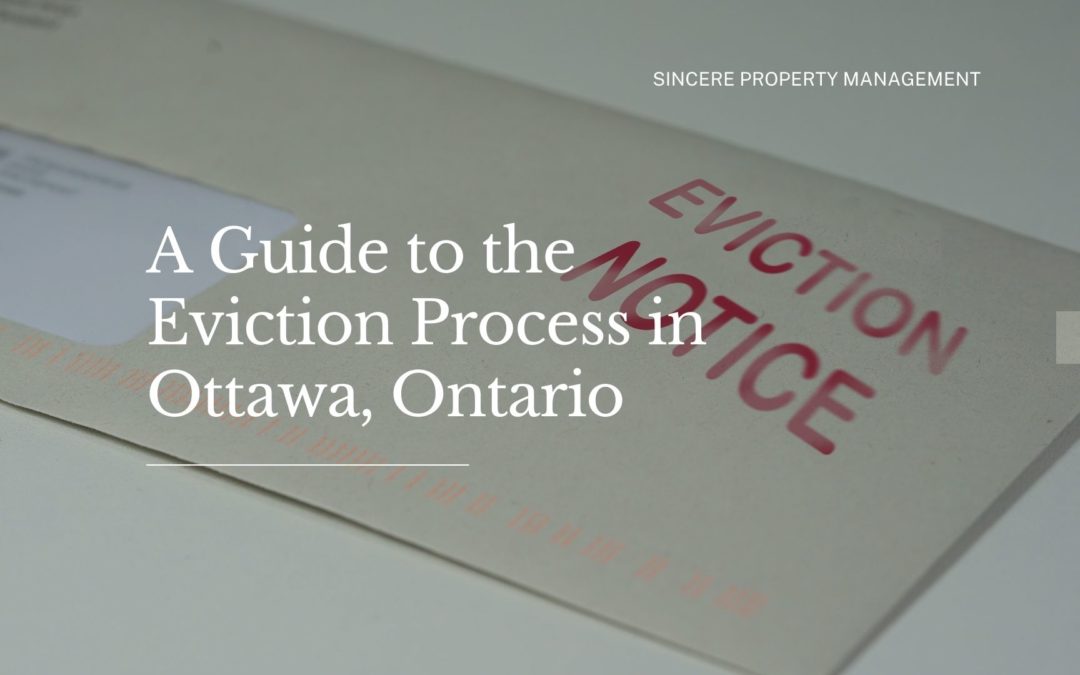As an Ontario landlord, ensuring a lawful eviction process is critical to preserving the value of your property investment. This article by Sincere Property Management aims to provide a comprehensive guide to the eviction process in Ontario, equipping landlords with the information they need to navigate this intricate situation.
Lease Termination with Legal Cause and Their Notices
Under Provincial landlord-tenant laws, an Ontario landlord can evict a renter for various reasons. What’s more, the type of eviction notice used is determined by the reason for the termination. Common reasons for eviction and their corresponding legal notices include:
Nonpayment of Rent
If a tenant fails to pay rent on time, a landlord has the right to initiate eviction proceedings. However, specific steps, such as providing proper notice, must be followed. Landlords must use the N4 – Notice to End a Tenancy Early for Non-payment of Rent form. This notice is used when a tenant fails to pay rent on time and gives them 14 days to pay the full, overdue rent or vacate the premises.
There’s also the N7 – Notice to End your Tenancy for Causes Other than Failure to Pay Rent or End a Term. This notice is for various reasons other than non-payment of rent or the end of a fixed-term lease. The tenant has 20 days to vacate the premises.

Violation of Lease Terms
These violations include activities prohibited in the lease, subletting without permission, or any other breach of the agreed-upon terms. The N5 – Notice to End your Tenancy for Interfering with Others, Damage, or Overcrowding, gives the tenant 20 days to correct the behavior or vacate the premises.
Illegal Activities
Engaging in illegal activities on the rental property is grounds for eviction. The N6 – Notice to End your Tenancy for Illegal Acts or Misrepresenting Income in a Rent-Geared-to-Income (RGI) Housing gives a tenant 20 days to correct the behavior or vacate the premises.
Additional Reasons for Eviction
Other valid reasons to evict a tenant include:
- Causing Disturbances: If a tenant consistently causes significant disturbances to neighbors or fellow tenants, the landlord may have grounds for eviction.
- Failure to Maintain Property: If a tenant fails to maintain the rental property and causes substantial damage beyond normal wear and tear, the landlord may have legal grounds for eviction. Repairing damage beyond wear and tear can potentially be covered by the tenant’s security deposit.
- End of Term for Fixed-Term Lease: If the lease is for a fixed term and the term is ending, the landlord is not required to renew the lease. However, proper notice must be given according to the Residential Tenancies Act.

Other Types of Eviction Notices in Ontario
Here are some other common types of eviction notices used in Ontario:
- N8 – Notice to End your Tenancy at the End of the Term for Landlord’s or Purchaser’s Own Use. This notice is used when the landlord or an immediate family intends to move into the unit or sell the property. The tenant must vacate at the end of the term.
- N13 – Notice to End your Tenancy Because the Landlord Wants to Demolish the Rental Unit, Repair it or Convert it to Another Use. This notice is used when the landlord intends to demolish, repair, or convert the rental unit to another use. The tenant must vacate at the end of the term.
- N15 – Notice to End your Tenancy Because the Landlord Wants to Convert the Rental Unit to a Condominium. This notice is used when the landlord plans to convert the rental unit into a condominium. The tenant must vacate at the end of the term.
Tenant Eviction Defences in Ontario
In Ontario, tenants facing eviction have the right to present defences during court proceedings. These defences are reasons why the landlord (the petitioner) should not win the case. While each case is unique, tenants commonly claim a variety of defences to counter eviction efforts. Some potential tenant eviction defences in Ontario are:
- Insufficient Notice
- Incorrect Rent Amount
- Uninhabitable Living Conditions

Attending Court Hearing
In Ontario, both the landlord and tenant are required to attend the eviction court hearing. If the tenant loses the lawsuit, they typically have around 10 days to settle the past due rent and court costs to avoid eviction. Conversely, if the tenant wins, they retain the right to stay on the property. Failure of a tenant to appear in court may result in an automatic loss.
Writ of Restitution
If a tenant continues to occupy the premises ten days after the court judgment, the court may issue a Writ of Restitution. This writ allows the landlord to regain possession of the property through the Sheriff’s department or a court officer. The landlord must select a date for eviction, usually resulting in a 1-2 week wait.
The Eviction
Once the Writ of Restitution is served, the Sheriff or court officer facilitates the physical removal of the tenant’s belongings. Landlords in Ontario are not required to store the renter’s property offsite; instead, they can leave furniture and appliances on the curb for approximately 48 hours before disposal.
Bottom Line
As a landlord, it’s vital that you understand the legal eviction process and abide by any other rental laws. If you need help hire the services of a qualified Ontario attorney. Alternatively, you can seek help from a knowledgeable property management company like Sincere Property Management.
Disclaimer: Please note that the information provided in this blog is intended for general guidance and should not be considered as a replacement for professional legal advice. It is important to be aware that laws pertaining to property management may change, rendering this information outdated by the time you read it.


I do not even know how I ended up here but I thought this post was great I dont know who you are but definitely youre going to a famous blogger if you arent already Cheers.